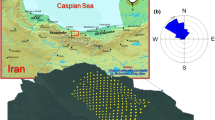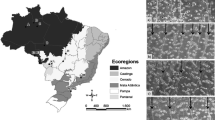Based on growth data obtained from 13 804 individual trees in 110 permanent plots, diameter at breast height (d.b.h.) growth was modeled for six major tree species growing in Hokkaido Island, northern Japan. For each species, d.b.h. growth was regressed on independent variables, indicating the effects of initial size, competition, climate and topography. In developing the d.b.h. growth models, independent variables were selected using the stepwise method. For all species analyzed, the final models accounted for significant amounts of the variation (r2 = 5.65−20.99%; P < 5%) in d.b.h. growth. Significant (P < 5%) effects of competition, climate and topography on d.b.h. growth were detected. The model obtained can be used in simulations of forest dynamics. Some ecological questions were examined using the d.b.h. growth models obtained. For hardwoods, the d.b.h. growth rate did not correlate with the published grouping of species in terms of shade-tolerance; however, the plasticity in d.b.h. growth in the presence of competition seemed to be correlated with the shade-tolerance of species. The degree of asymmetry in competition evaluated for each species was not correlated with the availability of underground resources, which was expressed by surrogate variables (mean values of climatic and topographic variables for species). The degree of asymmetry in competition was not different between conifers and hardwoods.
Similar content being viewed by others
REFERENCES
Abe N. (1991) Forest management support system for Abies sachalinensis MAST. planted forest (I) Estimation of site index for yield at sub-compartment by planted direction of a slope. Transactions of the 102nd Annual Meeting of the Japanese Forestry Society 102: 159–160. (in Japanese).
Abrams M. D., Copenheaver C. A., Terazawa K., Umeki K., Takiya M., Akashi N. (1999) A 370-year dendroecological history of an old-growth Abies–Acer–Quercus forest in Hokkaido, northern Japan. Canadian Journal of Forest Science 29: 1891–1899.
Anonymous (1984). Manual for Permanent Plot Census. Office of Prefectural Forest Management, Sapporo (in Japanese).
Barclay H. J. & Layton C. R. (1990) Growth and mortality in managed Douglas fir: Relation to a competition index. Forest Ecology and Management 36: 187–204.
Bazzaz F. A. (1979) The physiological ecology of plant succession. Annual Review of Ecology and Systematics 10: 351–371.
Botkin D. B. (1993) Forest Dynamics: an Ecological Model. Oxford University Press, Oxford.
Grime J. P. (1979) Plant Strategies and Vegetation Processes. John Wiley & Sons, Chichester.
Hairston A. B. & Grigal D. F. (1991) Topographic influences on soils and trees within single mapping units on a sandy outwash landscape. Forest Ecology and Management 43: 35–45.
Hara T. (1992) Effects of the mode of competition on stationary size distribution in plant populations. Annals of Botany 69: 509–513.
Hara T. (1993a) Effects of variation in individual growth on plant species coexistence. Journal of Vegetation Science 4: 409–416.
Hara T. (1993b) Mode of competition and size-structure dynamics in plant communities. Plant Species Biology 8: 75–84.
Harper J. L. (1977) Population Biology of Plants. Academic Press, London.
Hatakeyama S. (1981) Genetical and breeding studies on the regional differences of interprovenence variation in Abies sachalinensis MAST. Bulletin of the Hokkaido Forest Experiment Station 19: 1–91 (in Japanese with English summary).
Higo M. (1987) Growth characteristics of Quercus mongolica var. grosseserrata, Tilia japonica and Acer mono seedlings. Research Bulletin of the College Experiment Forests Hokkaido University 44: 139–152 (in Japanese with English summary).
Hiura T., Fujiwara K., Hojyo H., Okada J., Udo H., Okuyama S., Morita H., Fukuta H., Fujito E., Fukui T., Takahata M., Arikura K., Sugiyama H., Takeda T. (1995) Stand structure and long-term dynamics of primeval forests in Nakagawa Experimental Forest, Hokkaido University. Research Bulletin of the Hokkaido University Forests 52: 85–94 (in Japanese with English summary).
Hiura T., Uejima N., Okuda A., Hohjo H., Ishida N., Okuyama S. (1998) Crowding effects on diameter growth for Abies sachalinensis, Quercus crispula and Acer mono trees in a northern mixed forest, Nakagawa Experimental Forest. Research Bulletin of the Hokkaido University Forests 55: 255–261 (in Japanese with English summary).
Huang S. & Titus S. J. (1995) An individual tree diameter increment model for White Spruce in Alberta. Canadian Journal of Forest Research 25: 1455–1465.
Ishikawa Y., Haruki M., Ito K. (1986) Ecological studies of mixed forests in Nopporo national forest, central Hokkaido, Japan: Relationships between the distribution of aged forests and environmental factors. Environmental Science, Hokkaido 9: 225–238.
Ishikawa Y. & Ito K. (1989) The regeneration process in a mixed forest in central Hokkaido, Japan. Vegetatio 79: 75–84.
Ishizuka M. & Sugawara S. (1986) Composition and structure of natural mixed forests in central Hokkaido (I) Composition differences and species characteristics by elevation and from disturbance. Journal of the Japanese Forestry Society 68: 79–86.
Ishizuka M. & Sugawara S. (1989) Composition and structure of natural mixed forests in central Hokkaido (II) Effect of disturbances on the forest vegetation patterns along the topographic moisture gradients. Journal of the Japanese Forestry Society. 71: 89–98.
Jenny H. (1980) The Soil Resource: Origin and Behavior. Springer-Verlag, New York, pp. 276–304.
Kikuzawa K., Asai T., Fukuchi M., Mizutani E. (1979) Structure and growth of deciduous hardwood stand in Hokkaido (I) An analysis of stand in Mikasa City. Bulletin of the Hokkaido Forest Experiment Station 17: 1–11 (in Japanese with English summary).
Kikuzawa K. & Umeki K. (1996) Effect of canopy structure on degree of asymmetry of competition in two forest stands in northern Japan. Annals of Botany 77: 565–571.
Kimura N., Ogasawara S., Kisanuki H., Kurahashi A., Watanabe S. (1996) Survival process variation of seven Ezo spruce (Picea jezoensis) proveneances under the nursery condition. Transactions of the Meeting in Hokkaido Branch of the Japanese Forestry Society 44: 95–97 (in Japanese).
Kira T. (1991) Forest ecosystems of east and southeast Asia in a global perspective. Ecological Research 6: 185–200.
Kisanuki H. & Kurahashi A. (1998) Difference in growth and first seed production of Quercus mongolica var. grosseserrata among some provenance. Transactions of the Meeting in Hokkaido Branch of the Japanese Forestry Society 46: 160–162. (in Japanese).
Kohyama T. & Shigesada N. (1995) A size-distribution-based model of forest dynamics along a latitudinal enironmental gradient. Vegetatio 121: 117–126.
Koike T. (1988) Leaf structure and photosynthetic performance as related to the forest succession of deciduous broad-leaved trees. Plant Species Biology 3: 77–87.
Kubota Y. & Hara T. (1995) Canopy tree competition and species coexistence in a sub-boreal forest, northern Japan. Annals of Botany 76: 503–512.
Kubota Y., Konno Y., Hiura T. (1994) Stand structure and growth patterns of understorey trees in a coniferous forest, Taisetsuzan National Park, northern Japan. Ecological Research 9: 333–341.
Monserud R. A. & Sterba H. (1996) A basal area increment model for individual trees growing in even- and uneven-aged forest stands in Austria. Forest Ecology and Management 80: 57–80.
Murphy P. A. & Shelton M. G. (1996) An individual-tree basal area growth model for loblolly pine stands. Canadian Journal of Forest Research 26: 327–331.
Namikawa K., Ishikawa Y., Sano J. (1997) Stand dynamics during a 12 year period in a second-growth stand in a cool temperate forest in northern Japan. Ecological Research 12: 277–287.
Peet R. K. & Christensen N. L. (1980) Succession: a population process. Vegetatio 43: 131–140.
Quicke H. E., Meldahl R. S., Kush J. S. (1994) Basal area growth of individual trees: a model derived from a regional longleaf pine growth study. Forest Science 40: 528–542.
Ryan T. P. (1997) Modern Regression Methods. John Wiley & Sons, New York.
Sato T. (1992) Comparison of branching pattern between Abies sachalinensis and Picea jezoensis saplings. Transactions of the Meeting in Hokkaido Branch of the Japanese Forestry Society 40: 86–88 (in Japanese).
Schwinning S. & Weiner J. (1998) Mechanisms determining the degree of size asymmetry in competition among plants. Oecologia 113: 447–455.
Smith S. H. & Bell J. F. (1983) Using competitive stress index to estimate diameter growth for thinned Douglas-fir stands. Forest Science 29: 491–499.
Stage A. R. (1976) An expression for the effect of aspect, slope and habitat type on tree growth. Forest Science 22: 457–460.
Terazawa K. & Usui G. (1987) Distribution and seasonal change of potential evapotranspiration/precipitation from May to October in Hokkaido. Bulletin of Hokkaido Forest Experiment Station 25: 36–49. (in Japanese with English summary).
Uemura S. (1994) Climatic preferences and frequent co-occurrence of boreal and temperate plants in Hokkaido Island, northern Japan. Vegetatio 112: 113–126.
Umeki K. & Kikuzawa K. (1999) Long-term growth dynamics of natural forests in Hokkaido Island, northern Japan. Journal of Vegetation Science 10: 815–824.
Usui G. (1981) Cloudless solar irradiation on slopes in Hokkaido, with tables for 42–45 latitude. Transactions of the Annual Meeting of the Japanese Forestry Society 92: 173–176 (in Japanese).
Watanabe S. (1994) Specia of Trees. University of Tokyo Press, Tokyo (in Japanese).
Weiner J. (1990) Asymmetric competition in plant populations. Trends in Ecology and Evolution 5: 360–364.
Whittaker R. H. (1975) Communities and Ecosystems, 2nd edn. Macmillan, New York.
Wright E. F., Coates K. D., Canham C. D., Bartemucci P. (1998) Species variability in growth response to light across climatic regions in northwestern British Columbia. Canadian Journal of Forest Research 28: 871–886.
Wykoff W. R. (1990) A basal area increment model for individual conifers in the northern Rocky Mountains. Forest Science 36: 1077–1104.
Yanagisawa N. & Fujita N. (1999) Different distribution patterns of woody species on a slope in relation to vertical root distribution and dynamics of soil moisture profiles. Ecological Research 14: 165–177.
Yim Y.-J. & Kira T. (1975) Distribution of forest vegetation and climate in the Korean Peninsula. I. Distribution of some indices of thermal climate. Japanese Journal of Ecology 25: 77–88.
Yokozawa M. & Hara T. (1992) A canopy photosynthesis model for the dynamics of size structure and self-thinning in plant populations. Annals of Botany 70: 305–316.
Author information
Authors and Affiliations
Corresponding author
About this article
Cite this article
Umeki, K. Growth characteristics of six tree species on Hokkaido Island, northern Japan. Ecol Res 16, 435–450 (2001). https://doi.org/10.1046/j.1440-1703.2001.00409.x
Received:
Accepted:
Issue Date:
DOI: https://doi.org/10.1046/j.1440-1703.2001.00409.x




